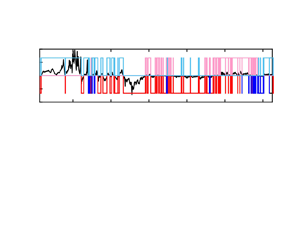Published online by Cambridge University Press: 27 May 2022

We investigate the intermittent dynamics of momentum transport and its underlying time scales in the near-wall region of the neutrally stratified atmospheric boundary layer in the presence of a vegetation canopy. This is achieved through an empirical analysis of the persistence time scales (periods between successive zero-crossings) of momentum flux events, and their connection to the ejection–sweep cycle. Using high-frequency measurements from the GoAmazon campaign, spanning multiple heights within and above a dense canopy, the analysis suggests that, when the persistence time scales ( $t_p$) of momentum flux events from four different quadrants are separately normalized by
$t_p$) of momentum flux events from four different quadrants are separately normalized by  $\varGamma _{w}$ (integral time scale of the vertical velocity), their distributions
$\varGamma _{w}$ (integral time scale of the vertical velocity), their distributions  $P(t_p/\varGamma _{w})$ remain height-invariant. This result points to a persistent memory imposed by canopy-induced coherent structures, and to their role as an efficient momentum-transporting mechanism between the canopy airspace and the region immediately above. Moreover,
$P(t_p/\varGamma _{w})$ remain height-invariant. This result points to a persistent memory imposed by canopy-induced coherent structures, and to their role as an efficient momentum-transporting mechanism between the canopy airspace and the region immediately above. Moreover,  $P(t_p/\varGamma _{w})$ exhibits a power-law scaling at times
$P(t_p/\varGamma _{w})$ exhibits a power-law scaling at times  $t_{p}<\varGamma _{w}$, with an exponential tail appearing for
$t_{p}<\varGamma _{w}$, with an exponential tail appearing for  $t_{p} \geq \varGamma _{w}$. By separating the flux events based on
$t_{p} \geq \varGamma _{w}$. By separating the flux events based on  $t_p$, we discover that around 80 % of the momentum is transported through the long-lived events (
$t_p$, we discover that around 80 % of the momentum is transported through the long-lived events ( $t_{p} \geq \varGamma _{w}$) at heights immediately above the canopy, while the short-lived ones (
$t_{p} \geq \varGamma _{w}$) at heights immediately above the canopy, while the short-lived ones ( $t_{p} < \varGamma _{w}$) only contribute marginally (
$t_{p} < \varGamma _{w}$) only contribute marginally ( $\approx 20\,\%$). To explain the role of instantaneous flux amplitudes in momentum transport, we compare the measurements with newly developed surrogate data and establish that the range of time scales involved with amplitude variations in the fluxes tends to increase as one transitions from within to above the canopy.
$\approx 20\,\%$). To explain the role of instantaneous flux amplitudes in momentum transport, we compare the measurements with newly developed surrogate data and establish that the range of time scales involved with amplitude variations in the fluxes tends to increase as one transitions from within to above the canopy.